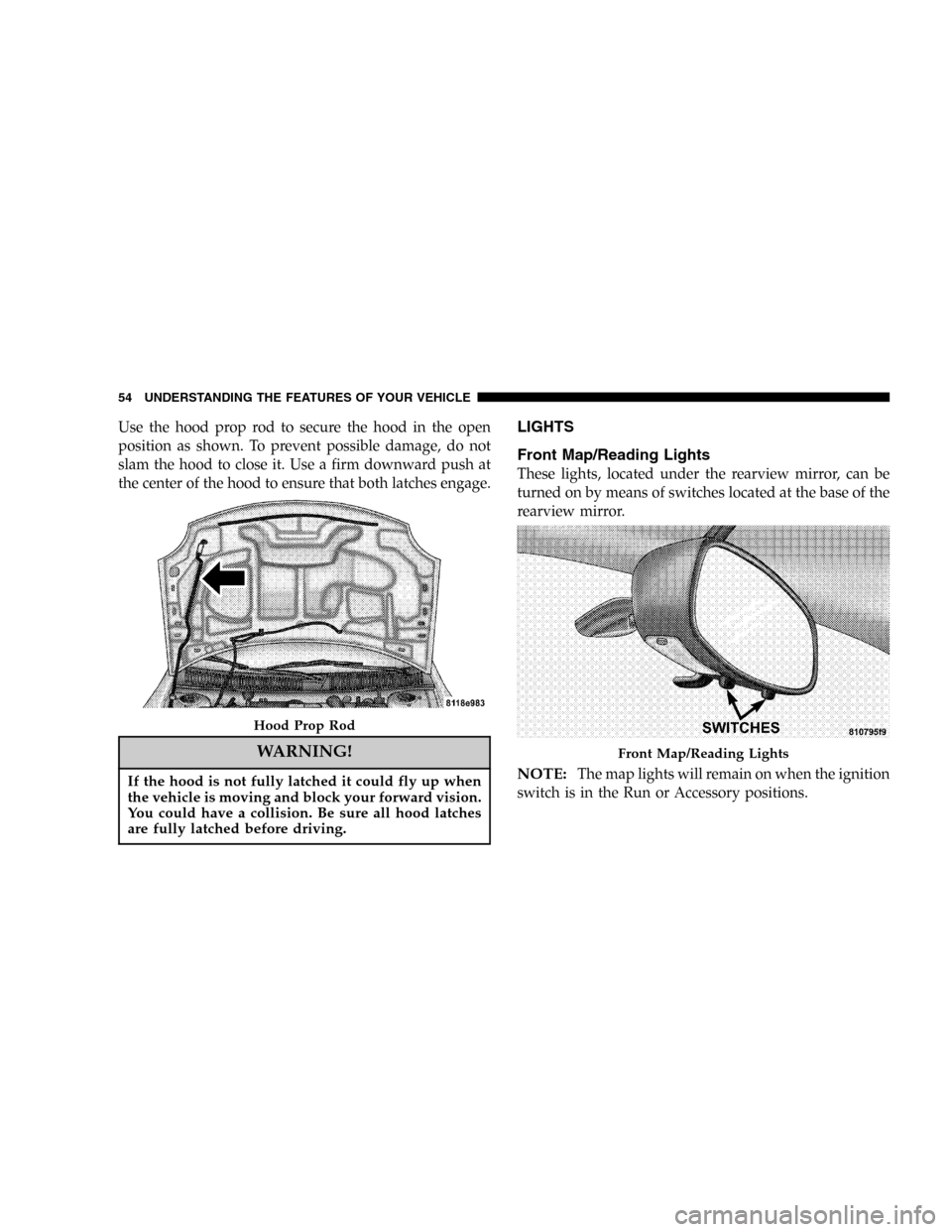2005 DODGE NEON SRT warning lights
[x] Cancel search: warning lightsPage 37 of 216

•In moderate to severe side collisions, the side airbag
inflator on the crash side of the vehicle is triggered by
the appropriate SIACM, releasing a quantity of non-
toxic gas. The inflating side airbag exits through the
seat seam into the space between the occupant and the
door. The side airbag moves at a very high speed and
with such a high force, that it could injure you if you
are not seated properly, or if items are positioned in
the area where the side airbag inflates. This especially
applies to children.
Enhanced Accident Response Time—If Equipped
If the airbags deploy after an impact and the electrical
system remains functional, vehicles equipped with
power door locks will unlock automatically. In addition,
approximately 10 seconds after the vehicle has stopped
moving, the interior lights will light until the ignition
switch is turned off.
Maintaining Your Airbag Systems
WARNING!
•Modifications to any part of the airbag system
could cause it to fail when you need it. You could
be injured because the airbags are not there to
protect you. Do not modify the components or
wiring, including adding any kind of badges or
stickers to the steering wheel hub trim cover or
the upper right side of the instrument panel. Do
not modify the front bumper, vehicle body struc-
ture, or frame.
•You need proper knee impact protection in a
collision. Do not mount or locate any aftermarket
equipment on or behind the knee bolster.
•It is dangerous to try to repair any part of the
airbag system yourself. Be sure to tell anyone who
works on your vehicle that it has airbags.
THINGS TO KNOW BEFORE STARTING YOUR VEHICLE 37
2
Page 54 of 216

Use the hood prop rod to secure the hood in the open
position as shown. To prevent possible damage, do not
slam the hood to close it. Use a firm downward push at
the center of the hood to ensure that both latches engage.
WARNING!
If the hood is not fully latched it could fly up when
the vehicle is moving and block your forward vision.
You could have a collision. Be sure all hood latches
are fully latched before driving.
LIGHTS
Front Map/Reading Lights
These lights, located under the rearview mirror, can be
turned on by means of switches located at the base of the
rearview mirror.
NOTE:The map lights will remain on when the ignition
switch is in the Run or Accessory positions.
Hood Prop Rod
Front Map/Reading Lights
54 UNDERSTANDING THE FEATURES OF YOUR VEHICLE
Page 69 of 216

INSTRUMENT CLUSTER DESCRIPTIONS
1. Fog Light Indicator
This light shows when the fog lights are ON.
2. Brake System Warning Light
This light monitors various brake functions,
including brake fluid level and parking brake
application. If the brake light comes on, it may
indicate that the parking brake is applied, or there is a
low brake fluid level. It may also indicate an ABS
malfunction that could lead to reduced braking per-
formance.
WARNING!
Driving a vehicle with the brake light on is danger-
ous. A significant decrease in braking performance
or vehicle stability during braking may occur. It will
take you longer to stop the vehicle or will make your
vehicle harder to control. You could have an acci-
dent. Have the vehicle checked immediately.
The operation of the Brake Warning light can be checked
by turning the ignition key from the OFF to the ON
position. The light should illuminate for three seconds, or
until the engine is started, whichever comes first. The
light should then go out unless the parking brake is
applied or a brake fault is detected. If the light does not
illuminate, have the light inspected and serviced as soon
as possible.
The light will also come on when the parking brake is
applied with the ignition in the ON position.
NOTE:This light shows only that the parking brake is
on. It does not show the degree of brake application.
If the parking brake is off and the light remains on, have
the brake system inspected as soon as possible.
3. Anti-Lock Warning Light (ABS)
This light monitors the Anti-Lock Brake System
(ABS) described elsewhere in this manual. This
light will come on when the ignition key is turned to
the ON position and may stay on for as long as four
seconds.
UNDERSTANDING YOUR INSTRUMENT PANEL 69
4
Page 70 of 216

If the ABS light remains on or comes on during driving,
it indicates that the Anti-Lock portion of the brake system
is not functioning and that service is required, however,
the conventional brake system will continue to operate
normally provided that the BRAKE warning light is not
on.
If the ABS light is on, the brake system should be serviced
as soon as possible to restore the benefit of Anti-Lock
Brakes.
The warning light should be checked frequently to assure
that it is operating properly. Turn the ignition key to a
point midway between ON and START. The light should
come on. If the light does not come on, have the system
checked by an authorized dealer.
4. Speedometer
Indicates vehicle speed.
5. Turn Signal Indicators
The arrows will flash in unison with the exterior turn
signal, when using the turn signal lever.
6. High Beam Indicator
This light shows that the headlights are on high
beam. Pull the turn signal lever toward the
steering wheel to switch the headlights from high or
low beam.
7. Tachometer
The silver area of the scale shows the permissible engine
revolutions-per-minute (rpm x 1000) for each gear range.
Before reaching the red area, ease up on the accelerator to
prevent engine damage.
8. Oil Pressure Light
Shows low engine oil pressure. The light will
come on and remain on when the ignition key is
turned from OFF to the ON position, and the light will
turn off after the engine is started. If the bulb does not
come on during starting, have the system checked by
an authorized dealer.
If the light comes on and remains on while driving, stop
the vehicle and shut off the engine. DO NOT OPERATE
THE VEHICLE UNTIL THE CAUSE IS CORRECTED.
70 UNDERSTANDING YOUR INSTRUMENT PANEL
Page 168 of 216

WARNING!
Do not use volatile solvents for cleaning purposes.
Many are potentially flammable, and if used in
closed areas they may cause respiratory harm.
Cleaning Headlights
Your vehicle has plastic headlights that are lighter and
less susceptible to stone breakage than glass headlights.
Plastic is not as scratch resistant as glass and therefore
different lens cleaning procedures must be followed.
To minimize the possibility of scratching the lenses and
reducing light output, avoid wiping with a dry cloth. To
remove road dirt, wash with a mild soap solution fol-
lowed by rinsing.
Do not use abrasive cleaning components, solvents, steel
wool or other aggressive material to clean the lenses.
Glass Surfaces
All glass surfaces should be cleaned on a regular basis
with any commercial household-type glass cleaner.
Never use an abrasive type cleaner. Use caution when
cleaning inside rear windows equipped with electric
defrosters. Do not use scrapers or other sharp instru-
ments which may scratch the elements.
Instrument Panel Cover
The instrument panel cover has a low glare surface which
minimizes reflections in the windshield. Do not use
protectants or other products which may cause undesir-
able reflections. Use soap and warm water to restore the
low glare surface.
168 MAINTAINING YOUR VEHICLE
Page 173 of 216

VEHICLE STORAGE
If you will not be using your vehicle for more than 21
days you may want to take steps to preserve your battery.
You may:
•Disengage the mini fuse in the Power Distribution
Center labeled IOD (Ignition Off-Draw).
•Or, disconnect the negative cable from the battery.
REPLACEMENT BULBS
LIGHT BULBS—Inside Bulb No.
ABS Indicator.......................... LED
Airbag Indicator........................ LED
Brake System Warning Indicator............. LED
Climate Controls........................ LED
Console Gear Selector...................PC194
Dome Light............................T579
Glove Box............................PC194
Front Fog Indicator...................... LED
High Beam Indicator....................PC194
Instrument Cluster Illumination............PC194
Low Fuel Indicator....................... LEDLow Oil Pressure Indicator................. LED
Rear Cargo............................T906
Seat Belt Indicator....................... LED
Security Alarm Indicator................... LED
Malfunction Indicator Light................ LED
TRAC OFF Indicator..................... LED
Turn Signal Indicator....................PC194
Voltage Indicator........................ LED
All the inside bulbs are brass or glass wedge base.
Aluminum base bulbs are not approved and should not
be used for replacement.
LIGHTS BULBS—Outside Bulb No.
Headlight.............................9007
Front Park/Turn Signal Light.............3457AK
Front Side Marker Light.................... 168
Front Fog Light......................9145/H10
Center High Mounted Stop Light
(CHMSL).........................921–W16W
Rear Tail/Stop/Turn Signal Light......3157–P27/7W
Backup Light......................921–W16W
License Light........................... 168
MAINTAINING YOUR VEHICLE 173
7
Page 205 of 216

Break-In Recommendations, New Vehicle...... 45
Bulb Replacement...................173,174
Capacities, Antifreeze (Engine Coolant)...... 176
Capacities, Fluid....................... 176
Caps, Filler
Fuel............................... 124
Oil (Engine)......................... 148
Carbon Monoxide Warning............... 123
Catalytic Converter..................... 149
CD Changer........................... 79
CD Player...........................75,77
CD Player Maintenance................... 83
Center High Mounted Stop Light........... 176
Central Door Locks...................... 14
Central Locking......................... 14
Chains, Tire........................... 119
Changing A Flat Tire.................... 130
Charging System Light................... 71
Chart, Tire Sizing....................... 105
Child Restraint......................... 38
Child Safety Locks....................... 16
Circuit Breakers.....................170,171Cleaning
Glass.............................. 168
Headlights.......................... 168
Climate Control......................... 84
Clock................................. 74
Compact Disc Maintenance................ 83
Compact Spare Tire..................... 115
Console............................... 62
Contract, Service....................... 198
Cool Down, Turbo....................... 97
Coolant...........................176,177
Cooling System........................ 157
Adding Coolant (Antifreeze)............. 159
Coolant Level.....................157,160
Disposal of Used Coolant............... 159
Drain, Flush, and Refill................. 158
Inspection........................... 160
Points to Remember................159,161
Pressure Cap........................ 159
Rubber and Plastic Components.......... 161
Selection of Coolant................... 158
Corrosion Protection.................... 165
Crankcase Emission Control System......... 151
INDEX 205
10
Page 207 of 216

Exhaust Pipes......................... 156
Exhaust System........................ 156
Extender, Seat Belt....................... 30
Filters
Air Cleaner.......................... 151
Engine Fuel......................... 151
Engine Oil.......................149,177
Flashers
Hazard Warning...................... 128
Flooded Engine Starting................... 96
Fluid, Brake........................... 177
Fluid Capacities........................ 176
Fluid Leaks............................ 46
Fluid Level Checks
Manual Transaxle..................... 164
Fluids............................... 177
Fog Lights...........................57,69
Folding Rear Seat....................... 52
Freeing A Stuck Vehicle.................. 137
Front Suspension Ball Joints............... 154
Fuel..............................121,177
Adding............................. 124Capacity............................ 176
Filler Cap........................... 124
Filter.............................. 151
Gauge.............................. 71
Light............................... 71
Octane Rating........................ 121
Tank Capacity........................ 176
Fuel System Caution.................... 123
Fuses................................ 170
GasCap .............................. 124
Gasoline............................. 176
Gasoline, Reformulated.................. 121
Gasoline/Oxygenate Blends............... 122
Gauges
Coolant Temperature................... 73
Fuel................................ 71
Tachometer.......................... 70
Turbo Boost.......................91,121
General Information...................... 12
Glass Cleaning......................... 168
Hazard Warning Flasher.................. 128
INDEX 207
10